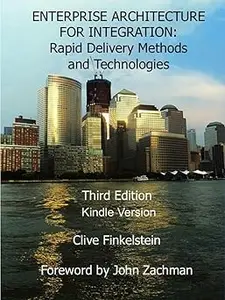
Free Download Clive Finkelstein, "Enterprise Architecture for Integration: Rapid Delivery Methods and Technologies"
English | ASIN : B011TR4W6K | 2015 | 630 pages | PDF | 12 MB
With the rapid pace of change today, the need for transformation from today's inflexible business environment to an agile enterprise that can change direction rapidly has never been greater. Yet the structures, processes and systems that we have today are inflexible: they are incapable of rapid change. This is not only a computer problem. It is also a business problem.
What are needed are methods and technologies for rapid business change - with systems that also change in lock step. This is a How-To-Do-It Book that shows you how to resolve these problems. The solution to this business problem uses Enterprise Architecture for Integration, with business-driven and data-driven rapid delivery methods that enable senior business managers, together with their corporate planners; business experts and IT staff, to work together to achieve business change. These methods use business integration to make the required business change transformations. The methods to achieve this are being successfully applied today by many enterprises throughout the world.
The solution to the computer problem uses the technologies of Extensible Markup Language (XML), Enterprise Application Integration (EAI), Enterprise Portals, Web Services and Service Oriented Architecture (SOA) with Business Process Management (BPM) languages that are automatically generated from process or workflow diagrams. These rapid delivery technologies and related products can be used with rapid delivery business methods to deliver priority systems and databases rapidly into production in 3-month increments.
Large projects that take years before they deliver any business value are no longer acceptable. The databases and systems that are designed and built for tomorrow should be capable of being progressively delivered into production: so that priorities are deliverd first, in 3-month increments. This book shows how you can achieve this, using the latest methods and technologies. Each chapter is written to cover all relevant concepts so it can be used stand-alone. The rapid delivery methods and technologies in this book promise to transform systems development for 21st Century enterprises into a rapid-delivery discipline.
The author, Clive Finkelstein, is the "Father" of Information Engineering (IE), originally developed by him and his company: Information Engineering Services Pty Ltd (IES) from 1976 - 1980. He is a leading authority in both methodologies and technologies - an unusual combination in today's complex world. In a "How-To-Do-It" style he details an enhanced version of IE: (called "Enterprise Engineering") that he has developed as the rapid delivery methods needed for Enterprise Architecture and for Business Transformation success.
In clear, understandable language using many informative diagrams, charts and : in 541 pages - plus 263 pages to be downloaded online - he uses case study examples and exercise problems, along with sample solutions, product descriptions and chapter summaries to cover the latest rapid delivery methods and enterprise integration technologies, along with numerous examples of vendor products and strategies.
The First Edition of this book covered V1.0 of the Zachman Framework for Enterprise Architecture and described rapid delivery methods for delivery of priority processes and databases into production. It covered rapid delivery technology products for Enterprise Application Integration (EAI). Enterprise Portals, Web Services, Service Oriented Architecture (SOA) and Business Process Management (BPM) that became available around 2005.
The Second and Third Editions of the book covered V3.0 of the Zachman Framework and its business focus, with extensive clarification in Part II on Rapid Delivery Methods and Business Process Management Notation (BPMN). Part III on Rapid Delivery Technologies covered the latest developments and products up to 2015 for SOA, Web Services, Web 2.0, Rich Internet Applications (RIA) and Cloud Computing.
Read more
